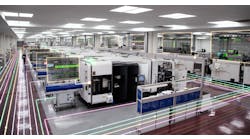Though they are time-consuming and prone to numerous errors, manufacturing plants everywhere continue to use manual data-collection techniques as the basis of their equipment maintenance programs. To save labor and time consumed by troubleshooting, industrial operations increasingly require automated monitoring devices capable of performing these tasks with precision. CAS DataLoggers, in partnership with dataTaker is introducing the Series 3 dataTaker DT85 Intelligent Universal Input Data Logger for machine monitoring. This automated system is versatile enough to measure nearly any physical value at high accuracy while simultaneously connecting to a large number of inputs. The Series 3 DT85 data logger also includes an extensive communications suite that makes it cost-effective for remote monitoring as well as real-time data acquisition and control.
These are “intelligent” data loggers that accommodate most equipment monitoring applications easily, with 16 to 48 universal analog sensor channels and 12 digital channels; four high-speed counter inputs; phase encoder inputs; and programmable serial sensor channels. These details make it possible to connect to most sensors and data measurement sources so that the DT85 can scale and log almost any physical value, including temperature, voltage, current, 4-20 mA loops, resistance, strain gauges, and frequency, among others.
Measurements are made at an 18-bit resolution across a ±30 V-input measurement range, and for more demanding applications, the dataTaker DT85 is expandable up to 900 analog inputs. The built-in display clearly shows all current readings. The data logger can store up to 10 million data points in user-defined memory and features independent control of schedule size and mode to log only as long as needed. The DT85 also archives data on alarm events, copying to USB memory and transferring via FTP if needed, providing data directly to the office over the internet or mobile phone network without the need for any polling or specific host software.
The new dataTaker DT85 Series 3 offers additional functionality, including cold junction compensation using an accurate RTD sensor accurate to 0.1%, allowing up to 5x more accurate thermocouple measurements. For users monitoring sensor cable integrity, speed control, or other analog measurements, the dataTaker supports single-ended, two-wire resistance measurements that allows three resistance measurements per input channel. A 5V terminal has also been included to power external devices with a limit of 25mA, further increasing the DT85’s versatility.
dataTaker’s stand-alone data loggers are recognized for high-quality design and construction, and for the ability to withstand rough handling and environments, intended for years of constant use. Communications capabilities include RS232 with modem support, USB, Ethernet and USB memory stick ports so that users can choose to connect to the DT85 locally, remotely or over the Internet. This versatility is increased with the logger’s multiple SDI-12 sensor networks, Modbus for SCADA systems, FTP and Web interface, making the DT85 ready to be rolled out in any number of industrial machine monitoring projects.
Free dEX graphical interface software is packaged with every dataTaker data logger, a user-friendly resource that speeds configuration so operators can view sensor measurements, calculations, and diagnostic information in real-time in a Windows Explorer style interface. Users can also view their real-time data as mimics, trend charts, or tables, and retrieve historical data for analysis. Users get a quick start on their projects since dEX comes built-in with no applications to install, runs directly from a web browser, and can be accessed either locally or remotely anywhere that a TCP/IP connection is available including worldwide over the Internet. Users can view dEX using any of the logger’s built-in communications ports including Ethernet, USB and RS-232.






